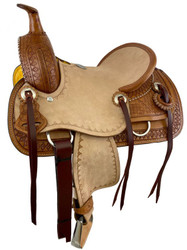The Western Saddle Parts to Know
29th Apr 2021
The Western Saddle
The Tree:
The foundation of the saddle is the tree. Today saddle trees are made of a choice of different materials. By far the best tree to go for is a "bull-hide covered hardwood" tree. This tree is made out of hardwood with one or two layers of wet Bull-hide or rawhide stretched over it. As the hide dries it shrinks forming a vice-like covering. This makes for a very resilient and strong tree, which however has an element of "give" in it. Inferior trees are often covered with canvas or cheesecloth or poorer quality hides (e.g., goat) and are suitable only for light pleasure use. Saddle trees are also made out of molded fiberglass and other plastics but again these generally are suitable only for pleasure use and not for Ranch and Rope work.
Bars:
The part of the tree that rests along the sides of the horse's spine is called the "bars." The size, shape and angle of the bars are what determine the fit. The three basic types of tree include the Quarterhorse (widest and longest bars, accommodating most "stock type" Quarterhorses), Semi-Quarterhorse (narrower bars, conforming to Thoroughbred type Quarterhorses), and Arabian tree (shorter bars, fitting shorter backed Arabian type horses). They should fit smoothly along the length of the horse's back and evenly distribute the pressure and weight of the rider and saddle. Both the length and angle of the bars affect how comfortably
the saddle fits the horse.
Swell/Fork:
Also called the Pommel. Fork design gives shape and definition to the front of the saddle. An "A-Fork" is just what it's name implies; the front of the saddle looks like an "A" as it rises from the bars to the horn. Other fork styles are somewhat broader in appearance, with more swell to the fork. The more swell to the fork, the more support you feel.
Gullet:
The design of the swell/fork, as well as the angle of the bars, help to determine the width and height of the saddle gullet. This, in turn, affects how well a saddle tree fits the horse's withers. The saddle must clear the withers. Too low a fit in this area and the horse can become sore quickly.
Horn:
This may be tall or short, thick or thin, and have a large horn cap or a small one. The angle used in attaching a horn to a tree also varies. The intended use for the saddle usually determines the horn design.
Cantle:
The term "high-backed saddle" refers to the cantle design used in the saddle tree. A higher-backed saddle can seem snugger in fit than a low one, given the seat measurement, simply because it offers more support in a higher position on the rider's back. This can come at a loss of flexibility for the rider so a lower cantle is often found in a roping saddle or when a quick dismount is needed such as in steer wrestling.
